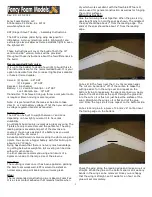
11
ENGLISH
DO NOT repeatedly inflate the glider and then allow it to crash
•
back down. Try to keep this movement as smooth as possible by
moving towards the glider as it comes down.
DO NOT slam your glider down on the ground leading edge first!
•
This impact puts great strain on the wing and stitching and can
even explode cells.
FLYING in salty air, in areas with abrasive surfaces (sand, rocks
•
etc.) and ground handling in strong winds will accelerate the ag-
ing process.
If you fly with a wrap, you should regularly undo the twisting that
•
appears on the main brake lines. By twisting the line become
shorter and you can end up with a constant tension on the trail-
ing edge (which can lead to problem on launch, stalling, glider not
flying symmetrically, ...)
Change your main brake lines if they are damaged.
•
It is recommended that you regularly CHECK your wing, especially
after a heavy period of use, after an incident or after a long period of
storage.
Storage
Always store all your flying equipment in a dry room, protected from
direct heat.
Your wing should be dry before being packed away. Moisture, heat and
humidity are the worst elements for damaging your glider. (Storing a
damp glider in your car under the sun would be terrible for example).
Dry your wing preferably out of the sun, in the wind. Never use a hair
dryer, etc.
If you land in the salt water, you must clean it with fresh water first
and then dry it.
Take care that no insects get packed away with the wing. They may
eat the cloth and make holes in a bid to escape. They can also leave
acidic deposits if they die and decompose.
IMPORTANT: Never pack away or store your glider wet.
Caring Tips
Careless ground handling damages many paragliders. Here are some
things to avoid in order to prolong the life of your aircraft:
DO NOT drag your wing along the ground to another take-off
•
position - this damages the sailcloth. Lift it up and carry it.
DO NOT try to open your wing in strong winds without untan-
•
gling the lines first - this puts unnecessary strain on the lines.
DO NOT walk on the wing or lines.
•
IMPORTANT: Do NOT lay the wing flat on the ground before
packing the glider, this will cause abrasion damage to the
top surface as you pull the glider towards the middle. AL-
WAYS pack from a mushroom or lift the wing off the ground
when gathering the wing and grouping the leading edge.
Important: Do not fold the glider in the centre, you will
bend the plastics, instead pack the wing with a full concer-
tina method from tip to tip before packing into the stuff sac.
=
=





































